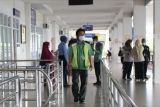Jakarta (ANTARA) - The US Centers for Disease Control and Prevention (CDC) has recognized Indonesia as a country with a low rate of COVID-19 transmission that served as a motivation for better compliance with health protocols, an official stated.
"The public, both in Indonesia and those keen to enter Indonesia, must (strictly follow) health protocols and comply with every government policy. There is no tolerance for those who violate the regulations," spokesperson for Vaccination at the Health Ministry Siti Nadia Tarmizi noted in a written statement received here on Monday.
The CDC announced that Indonesia is a safe country to visit on Monday, October 25, as it was considered as being at level 1 in terms of the COVID-19 transmission rate.
Tarmizi deemed this recognition to be a source of motivation that encourages Indonesia to become enthusiastic in freeing itself from the clutches of the COVID-19 pandemic.
Despite the positive development, Tarmizi reminded all to remain vigilant, as there was a lingering threat of the third wave and new variants of COVID-19.
Some of the neighboring countries, such as Singapore, Malaysia, Brunei, and Thailand, are still at Level 4 of the COVID-19 transmission rate, or high.
The government has continued to improve the quality and quantity in terms of handling COVID-19. The efforts range from epidemiological tests, increasing the tracing ratio of close contacts, and genomic surveillance.
Other efforts encompass converting as much as 30 to 40 percent of the bed capacity at hospitals and meeting the needs of oxygen supplies, medical devices and human resources, dispatching additional health workers, making stricter hospital admission requirements, and utilizing centralized isolation facilities.
The government also prioritizes areas with high cases and mobility by allocating 50 percent of the vaccines while also increasing the number of vaccination centers, enforcing vaccine card requirements, and accelerating vaccination.
The government imposes stricter community activities restriction level 1-4 as well as utilizes digital technology to monitor adherence to health protocols.
Baca juga: Mask-wearing protocol can help prevent third wave of COVID-19 infections: epidemiologist
Baca juga: Youth leverage for economic revival: deputy ministry










